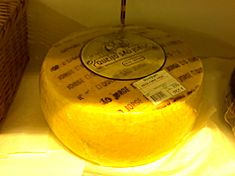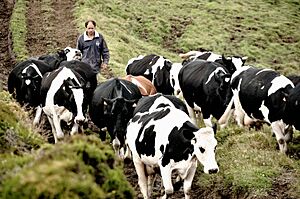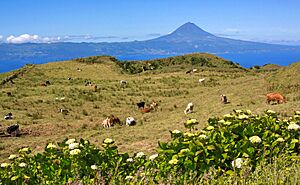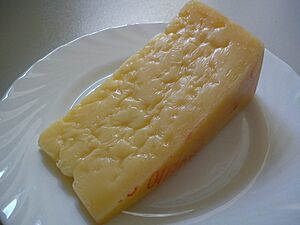São Jorge cheese facts for kids
Quick facts for kids Queijo São Jorge |
|
|---|---|
 |
|
| Other names | São Jorge Cheese |
| Country of origin | Portugal |
| Region | São Jorge (Azores) |
| Source of milk | Dairy cattle |
| Pasteurised | No |
| Texture | Hard; Semi-Hard |
| Fat content | Minimum fat content of 45% |
| Dimensions | 25–35 centimetres (9.8–13.8 in) diameter and 10–15 centimetres (3.9–5.9 in) height |
| Weight | 8–12 kilograms (18–26 lb) |
| Aging time | Minimum 3 months |
| Certification | Denominação de Origem Protegida (DOP), attributed to Queijo São Jorge. |
| Named after | Lua error in Module:Wikidata at line 70: attempt to index field 'wikibase' (a nil value). |
São Jorge Cheese (Portuguese: Queijo São Jorge) is a special type of cheese. It is made on São Jorge Island in the Azores, which is a group of islands belonging to Portugal. This cheese can be anywhere from semi-hard to hard. It has a special certification called Denominação de Origem Protegida (DOP). This means it's a protected product, and only cheese made in a specific way on São Jorge Island can be called São Jorge Cheese.
Contents
History of São Jorge Cheese
Cheese making on São Jorge Island started a very long time ago. It began when people first settled on the islands and brought cows with them. A historian named Gaspar Frutuoso wrote about it. He said that São Jorge had many cows, sheep, and goats. People made lots of cheese all year round. He thought the cheese from São Jorge was the best in all the Azores. This was because of the island's great pastures.
The weather on São Jorge Island helps the grass grow very well. This meant the cows produced more milk than people needed to eat right away. So, the islanders started making cheese. It was a good way to store food and use up the extra milk. The special taste of São Jorge cheese comes from the unique mix of grasses and plants on the island.
Some of the first settlers on São Jorge were from Flanders (a region in modern-day Belgium). They were led by Willem van der Haegen. These settlers found that the higher parts of São Jorge were similar to their homeland. These areas were perfect for raising cattle and making dairy products. Their knowledge helped cheese making grow on the island.
In the 1800s, a farmer named José Pereira da Cunha da Silveira e Sousa Júnior wrote about the cheese. He said that São Jorge was known as "the land of cheese." He noted that many people had been making cheese there for over a hundred years. Records from the island show that by the mid-1700s, cheese production was huge. They even exported cheese to other islands and countries. This early cheese was similar to the Flemish cheeses of that time.
Later, the Cunha da Silveira family, who owned large farms, helped improve cheese making. They brought in new techniques from other places. A person named Fernand Ranchel, from the House of Habsburg, visited São Jorge. He set up a factory to make a hard cheese. This hard cheese became the model for the Queijo de São Jorge we know today. Before this, people mostly made softer cheeses at home.
By the late 1700s, the cheese looked like it does now. It was a round, wheel-shaped cheese. Some very large ones were made for special occasions. For example, a nobleman once ordered a huge cheese as a gift for a bishop.
Because of its long history and importance, São Jorge Cheese was given special protection in 1986. It became a Região Demarcada do Queijo de São Jorge. This means it's a protected area for this cheese. It also got the Denominação de Origem Protegida (DOP) certification. This ensures its quality and origin. About 1,800 tons of this cheese are made each year. Around 800 farmers work with nine milk processing groups to make it. São Jorge cheese is a very important part of the island's economy. In 1991, a group called the Confraria do Queijo de São Jorge was formed. They help check the quality of the cheeses for certification.
How São Jorge Cheese is Made
São Jorge Cheese is made only from fresh, raw milk from cows on São Jorge Island. First, the milk is turned into a soft mass called curd. This happens by adding a special liquid from previous cheese making.
The curd is left to sit until it gets firm enough. Then, the liquid part (called whey) is drained away. Fine salt is added to the curd. About 2.8% of the curd's weight is salt. The salted curd is then shaped into round wheels. Each wheel gets a number and a code. This code tells you who made it and how old it is. This helps keep track of the cheese's quality.
Next, the cheese wheels are dried in special rooms. They cure (age) at room temperature for a few months. After that, they move to climate-controlled rooms. They stay there for at least 90 days. Some special cheeses are aged for up to 36 months!
After aging, the cheeses are checked for quality. They must meet all the rules for certification. A group of tasters tries the cheese to make sure it's perfect. Finally, the cheeses are stored in cool places until they are sold.
What Makes São Jorge Cheese Special
The rules for São Jorge Cheese say it must have certain qualities:
- It must be made only on São Jorge Island.
- It is a cured, firm cheese. It can be hard or semi-hard.
- The cheese is yellowish and has small, uneven holes inside.
- It is made from whole, raw cow's milk.
- The cheese must have a minimum fat content of 45% (when dry).
- It must be aged for at least three months.
- The cheese is round, like a wheel. It is about 25–35 cm (9.8–13.8 in) wide. It is about 10–15 cm (3.9–5.9 in) tall.
- The rind (outer skin) is hard and dark yellow. It might have reddish-brown spots. It can be smooth or covered with a clear coating.
- The inside of the cheese is firm, sometimes a bit crumbly. It's yellowish with many small, uneven holes.
- It has a strong, clean smell and taste. It's a little spicy, and this gets stronger as the cheese ages.
- Each cheese wheel weighs between 8–12 kilograms (18–26 lb).
- The cheese must age in rooms with temperatures between 12–14 °C (54–57 °F). The air should be 80% to 85% humid. There should also be some airflow. This aging must last at least three months.
See also
 In Spanish: Queijo São Jorge para niños
In Spanish: Queijo São Jorge para niños





